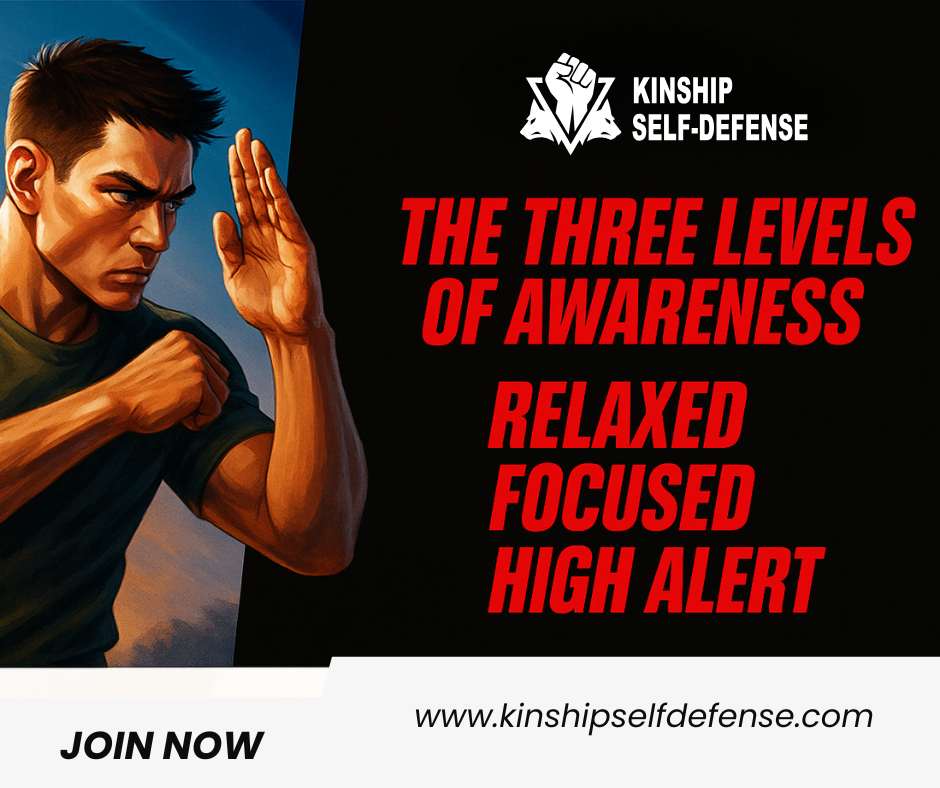Most people think self-defense starts with a punch, a block, or a martial arts move. In reality, the most powerful tool you have doesn’t involve fighting at all—it’s situational awareness. By noticing what’s happening around you, you give yourself the chance to avoid danger, act early, or respond from a position of control.
At Kinship Self Defense in Pretoria, we train our students not only in Krav Maga, boxing, and BJJ fundamentals, but also in how to see threats before they become emergencies. This article breaks down what situational awareness is, how it works, and how you can start practicing it every day.
What Is Situational Awareness?
Situational awareness means being consciously aware of your surroundings, the people in them, and potential risks or changes in the environment.
Think of it as upgrading from “autopilot mode” to active observation mode. Instead of being lost in your phone while walking to your car, you’re scanning the area, reading body language, and noticing escape routes.
It’s not paranoia—it’s a skill that balances calmness with readiness.
The Three Levels of Awareness
- Relaxed Awareness
- Baseline calm but alert. For example, walking while noting cars, people, and exits.
- Focused Awareness
- Something feels off, like someone following too closely. You’re ready to act.
- High Alert
- Danger is imminent, e.g., someone stepping aggressively into your space.
👉 For more about managing your reactions in high-stress moments, read The Science Behind Self-Defense Training: Strength, Awareness, and Reaction Time.
Why It Matters in Pretoria (and Anywhere)
Pretoria is vibrant but has risks—especially for women, students, or commuters at night. Criminals rely on surprise and distraction.
By sharpening awareness, you:
- Deter attackers: Predators look for easy, distracted targets.
- Buy time: Even two seconds of warning can make the difference.
- Boost confidence: Control reduces fear.
👉 See how this ties into Women’s Self Defense in Pretoria.
Practical Habits to Build Situational Awareness
- Break Phone Addiction – Keep your head up until you’re safe indoors.
- Use the “360 Scan” – Casually check surroundings every few minutes.
- Trust Your Gut – Your subconscious often picks up signals first.
- Choose Smart Seating – Sit where you can see doors.
- Identify Exits Early – Note escape routes in malls, taxis, gyms.
- Practice Mindful Walking – Notice who’s near you, what they carry, and unusual details.
👉 For drills you can try at home, check Self-Defense at Home: Solo and Partner Drills.
Situational Awareness + Self-Defense Training
Awareness is powerful alone, but pairing it with skills makes you resilient. At Kinship Self Defense, we train students to:
- Spot pre-attack cues like nervous movements.
- De-escalate with confident body language and voice.
- Use practical strikes only when needed.
Awareness gives you choices. Fighting becomes the last resort, not the first.
A Simple Daily Drill: The Color Code
Colonel Jeff Cooper’s color code:
- White: Unaware, distracted.
- Yellow: Relaxed awareness (default).
- Orange: Something suspicious draws attention.
- Red: Immediate danger, act now.
👉 For more on applying this system in daily life, see Understanding Crime Trends in Montana: Why Self Defense Matters More Than Ever.
Common Mistakes to Avoid
- Over-alertness: Staying tense drains energy.
- Ignoring instincts: Never dismiss gut feelings.
- Tunnel vision: Don’t fixate on one person and miss the bigger picture.
Situational Awareness for Women’s Safety
Women often face harassment, intimidation, or stalking. Awareness helps by:
- Choosing well-lit paths and exits.
- Setting verbal boundaries early.
- Identifying safe zones along routes.
👉 Pair these skills with Women’s Self Defense Classes to feel fully prepared.
Conclusion
Situational awareness is not about fear—it’s about freedom. When you stay alert, you control your space, reduce risks, and project confidence that discourages attackers.
At Kinship Self Defense in Pretoria, we see awareness as the first building block of safety—before any strike, block, or takedown. Awareness, paired with training, creates resilience.
👉 Start with our Complete Guide to Self-Defense Classes in Montana Pretoria or Contact us to begin.
